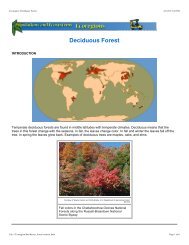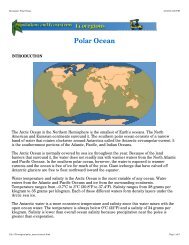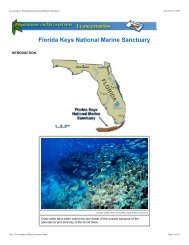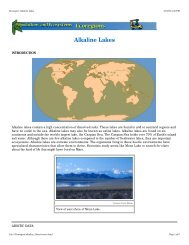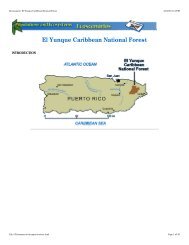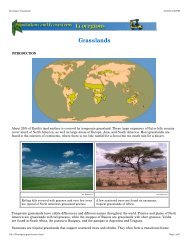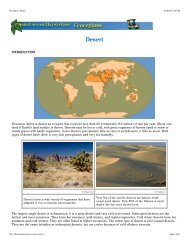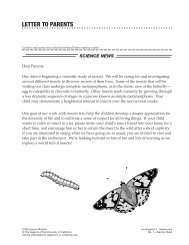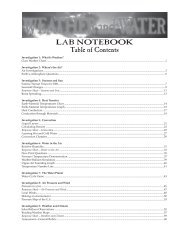Ecoscenarios Combined - FOSSweb
Ecoscenarios Combined - FOSSweb
Ecoscenarios Combined - FOSSweb
Create successful ePaper yourself
Turn your PDF publications into a flip-book with our unique Google optimized e-Paper software.
Ecoscenario: Mono Lake<br />
4/16/03 3:18 PM<br />
feed eagerly on the algae, and after a few weeks they mature and produce a huge second generation of brine shrimp. In June and July, 4<br />
or 5 trillion mature brine shrimp, each about 1 centimeter (0.4 inches) long, fill the lake.<br />
At the same time, the larvae of the brine flies (also known as alkali flies) that have been inactive on the lake bottom wake up and start<br />
eating the benthic algae that grow on the lake bottom. By midsummer, millions of brine flies are skittering across the surface of the lake.<br />
Courtesy of Teri Dannenberg<br />
California gulls feeding on brine flies at the<br />
shoreline. The darker area at the water's edge is<br />
adult brine flies.<br />
Courtesy of Teri Dannenberg<br />
Brine fly larvae and adults cover the lake bottom and<br />
the shoreline.<br />
The bounty of shrimp and flies is eaten by huge numbers of birds. Nesting birds include 50,000 California gulls (85% of California's<br />
breeding population and second largest colony in the world) and 400 snowy plovers (11% of the state's breeding population). Migratory<br />
birds include 1–2 million eared grebes (30% of the North American population), 80,000 Wilson's phalaropes (10% of the world<br />
population), 60,000 red-necked phalaropes (3% of the world population), and smaller numbers of 79 other species of water birds.<br />
Courtesy of Mono Lake Committee<br />
Courtesy of Mono Lake Committee<br />
A pair of mating brine shrimp<br />
Millions of birds feed on the trillions of brine shrimp in Mono<br />
Lake.<br />
Mono Lake is a critically important feeding stop for birds migrating south from Canada. The phalaropes and grebes arrive at the lake<br />
completely depleted of energy reserves. They linger there for several weeks, gorging on shrimp and flies until they have doubled their<br />
body weight with high-energy fats. Refueled and refreshed, they can complete their migration to Central and South America.<br />
With the departure of the last migrating birds, Mono Lake is briefly quiet. The surface is devoid of life—no flies, no birds. The lake water<br />
is clear and still. The brine shrimp ate all the algae, and in turn were eaten by the migratory birds. The brine shrimp egg cysts lie waiting<br />
on the lake bottom with the dormant larvae of the brine flies. The chill of autumn closes in, and Mono Lake gets cold. Then the lake turns<br />
over for the 760 thousandth time, and the few remaining algae respond. The cycle repeats.<br />
ISSUES<br />
There is really only one issue at Mono Lake...fresh water. Life depends on it in Mono Lake as surely as it does in every other ecosystem<br />
file:///Ecoscenario/mono/content.html<br />
Page 7 of 11



